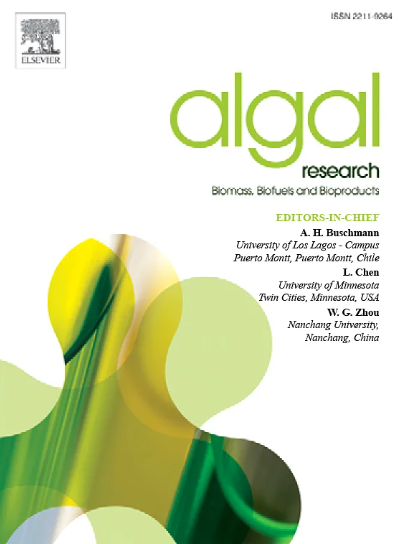Physicochemical, radical–scavenging, and anti-proliferative analyses of enzyme-assisted extracted polysaccharides unravel the potential of tropical green seaweeds
IF 4.6
2区 生物学
Q1 BIOTECHNOLOGY & APPLIED MICROBIOLOGY
Algal Research-Biomass Biofuels and Bioproducts
Pub Date : 2025-02-19
DOI:10.1016/j.algal.2025.103973
引用次数: 0
Abstract
This study focused on enzyme-assisted extraction of polysaccharides from four selected tropical green seaweeds (Caulerpa scalpelliformis, Ulva fasciata, Ulva lactuca, and Acrosiphonia orientalis). The polysaccharides were physicochemically characterized by using advanced analytical tools and also evaluated for their scavenging and anti-proliferative activities. Enzyme-assisted extraction yielded a higher polysaccharide content compared with traditional techniques. The extracted crude and purified polysaccharides were rich in sugars, including galactose and mannose. Functional group analysis based on Fourier-transform infrared spectroscopy confirmed the presence of characteristic polysaccharide groups, such as hydroxyl, carboxyl, and sulfate. The extracted polysaccharides were amorphous in nature with a fibrous and porous morphology, showing uneven aggregates. Different biological tests, including the ferric reducing antioxidant power and phosphomolybdate assays, revealed significant antioxidant activity. Furthermore, the anti-proliferative studies performed on two cancer cell lines (Huh-7 and HeLa) showed different degrees of inhibition, with certain purified fractions showing higher efficacy. Overall, the results indicate that these extracted polysaccharides have potential applications in nutraceutical, pharmaceutical, and therapeutic products, particularly as antioxidants and anti-cancer agents.
求助全文
约1分钟内获得全文
求助全文
来源期刊

Algal Research-Biomass Biofuels and Bioproducts
BIOTECHNOLOGY & APPLIED MICROBIOLOGY-
CiteScore
9.40
自引率
7.80%
发文量
332
期刊介绍:
Algal Research is an international phycology journal covering all areas of emerging technologies in algae biology, biomass production, cultivation, harvesting, extraction, bioproducts, biorefinery, engineering, and econometrics. Algae is defined to include cyanobacteria, microalgae, and protists and symbionts of interest in biotechnology. The journal publishes original research and reviews for the following scope: algal biology, including but not exclusive to: phylogeny, biodiversity, molecular traits, metabolic regulation, and genetic engineering, algal cultivation, e.g. phototrophic systems, heterotrophic systems, and mixotrophic systems, algal harvesting and extraction systems, biotechnology to convert algal biomass and components into biofuels and bioproducts, e.g., nutraceuticals, pharmaceuticals, animal feed, plastics, etc. algal products and their economic assessment
 求助内容:
求助内容: 应助结果提醒方式:
应助结果提醒方式:


